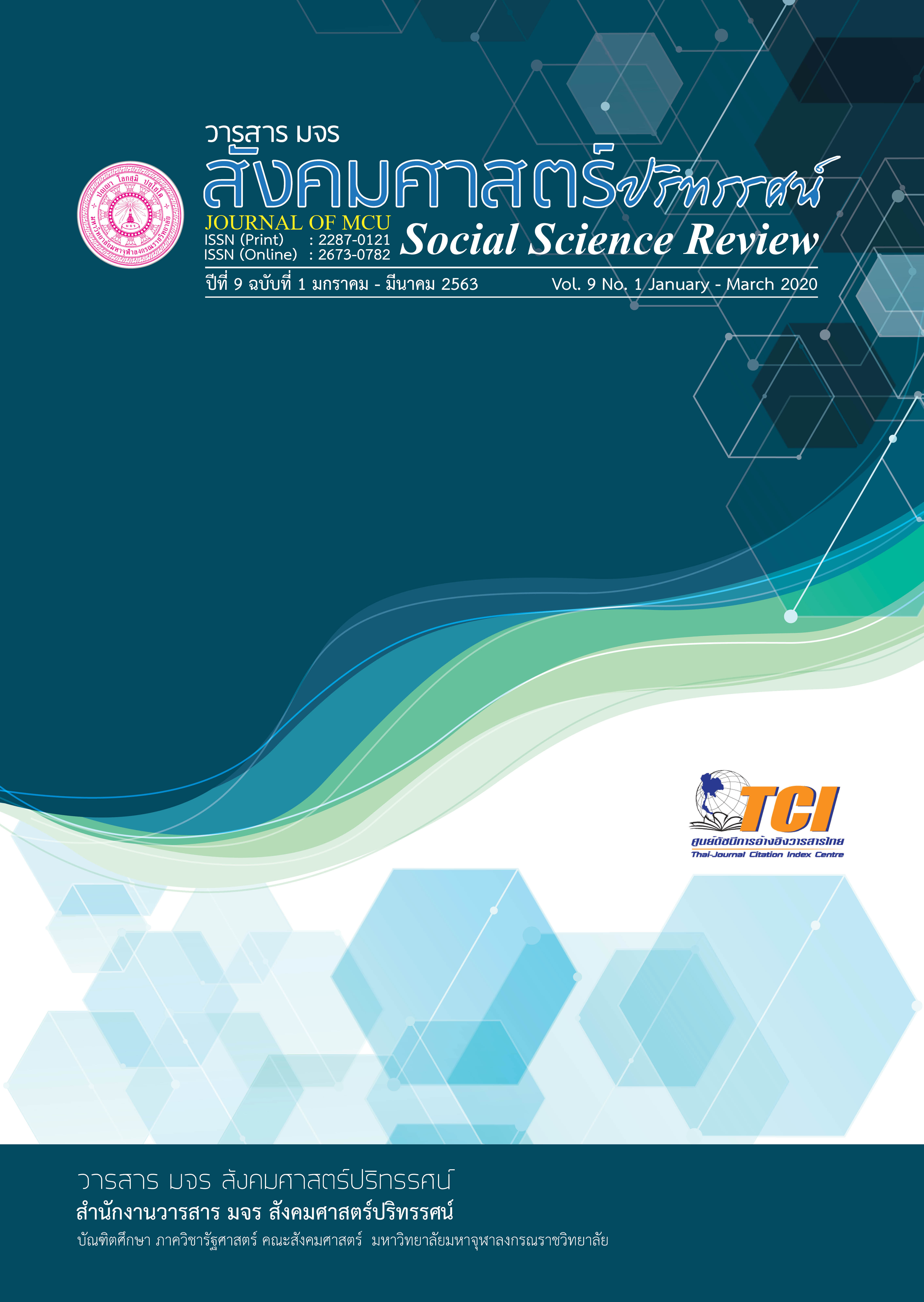MODEL OF HAPPINESS CREATION MONASTERY DEVELOPMENT WITH 5S’S ACTIVITY IN SINGBURI PROVINCE
Keywords:
Model, Happiness Creation Monastery Management, 5S’s ActivityAbstract
Objectives of this article were to study the general conditions, factors and a management model of monasteries applying the mixed methods collected data by in-depth-interviewing 18 key informants and from 12 participants who were experts in focus group discussion. Data were analyzed by descriptive interpretation. The quantitative research collected data from 184 samples with the questionnaires and analyzed data with frequencies, percentage, mean and standard deviation. Findings were as follows: 1. Monastery management was the main policy of the Sangha Order because it is the policy from the Supreme Sangha Council emphasizing that every monastery must conduct self development with 5 S’s activities. There was appointment of the committee to move the project. 2. Factors affecting the management of monasteries with 5 S’s activities were the management principle of POCCC and the happiness creation monastery management by Sappaya 3. The management model of the monasteries were: 1) There were monasteries plan and operation charts showing the area usage, dividing areas into monks’ abodes and Buddha’s area. 2) monastery development for being convenient to contact, parking areas were provided, clear signs for bus entering and descending with clear direction signs, . 3) green areas development, there should be appropriate and enough trees that yield pleasant shadows. 4) Sufficient water containers must be provided and placed in good and clean order with health standard.
References
พระครูวัชรสุวรรณาทร (ลูกชุบ ธมฺมโชโต). (2558). การประยุกต์ใช้อิทธิบาทธรรมเพื่อส่งเสริมกลยุทธ์การอนุรักษ์โบราณสถานของพระสังฆาธิการในเขตปกครองคณะสงฆ์ภาค 15 (วิทยานิพนธ์ปริญญาพุทธศาสตรดุษฎีบัณฑิต สาขาวิชาการจัดการเชิงพุทธ). พระนครศรีอยุธยา: มหาวิทยาลัยมหาจุฬาลงกรณราชวิทยาลัย.
พระครูวินัยธรธรรมภณ ธมฺมพโล (แก้วแจ่มศรี). (2558). การพัฒนาการจัดการศาสนสมบัติของวัดในจังหวัดพระนครศรีอยุธยา (วิทยานิพนธ์ปริญญาพุทธศาสตรดุษฎีบัณฑิต สาขาวิชาการจัดการเชิงพุทธ). พระนครศรีอยุธยา: มหาวิทยาลัยมหาจุฬาลงกรณราชวิทยาลัย.
พระครูวิสิฐพัชราจาร (ไชยยา เขมสิริ). (2558). การพัฒนาการจัดการสาธารณูปการของพระสังฆาธิการจังหวัดเพชรบุรี (วิทยานิพนธ์ปริญญาพุทธศาสตรดุษฎีบัณฑิต สาขาวิชาการจัดการเชิงพุทธ). พระนครศรีอยุธยา: มหาวิทยาลัยมหาจุฬาลงกรณราชวิทยาลัย.
พระครูวิสุทธินนทคุณ (ทวี สุทฺธิวํโส). (2558). บทบาทของวัดในการอนุรักษ์โบราณสถานในจังหวัดนนทบุรี (วิทยานิพนธ์ปริญญาพุทธศาสตรดุษฎีบัณฑิต สาขาวิชาการจัดการเชิงพุทธ). พระนครศรีอยุธยา: มหาวิทยาลัยมหาจุฬาลงกรณราชวิทยาลัย.
พระมหานพรักษ์ ขนฺติโสภโณ (นาเมือง). (2558). การบริหารจัดการวัดพัฒนาตัวอย่างในจังหวัดพระนครศรีอยุธยา (วิทยานิพนธ์ปริญญาพุทธศาสตรดุษฎีบัณฑิต สาขาวิชาการจัดการเชิงพุทธ). พระนครศรีอยุธยา: มหาวิทยาลัยมหาจุฬาลงกรณราชวิทยาลัย.
เรืองวิทย์ เกษสุวรรณ. (2545). การจัดการคุณภาพ: จาก TQC ถึง TQM. ISO 900 และการประกันคุณภาพ. กรุงเทพฯ: บพิธการพิมพ์.
พระพิพัฒน์ โสภณจิตฺโต ทับงาม. (2563). รูปแบบการบริหารจัดการของสำนักปฏิบัติธรรมประจำจังหวัดอ่างทอง เพื่อเสริมสร้างศักยภาพทางปัญญา. วารสารสันติศึกษาปริทรรศน์ มจร, 8(1), 222-232.
พระมหาจินตวัฒน์ จารุวฑฺฒโน. (2562). รูปแบบการบริหารวัดสร้างสุขด้วยกิจกรรม 5 ส จังหวัดสิงห์บุรี (ดุษฎีนิพนธ์ปริญญาพุทธศาสตรดุษฎีบัณฑิต สาขาวิชาการจัดการเชิงพุทธ). พระนครศรีอยุธยา: มหาวิทยาลัยมหาจุฬาลงกรณราชวิทยาลัย.
Ouchi, W. (1971). Organization and Management. Eaglewood Cliffs: Prentice Hill.
Downloads
Published
How to Cite
Issue
Section
License
Copyright (c) 2020 Journal of MCU Social Science Review

This work is licensed under a Creative Commons Attribution-NonCommercial-NoDerivatives 4.0 International License.
In order to conform the copyright law, all article authors must sign the consignment agreement to transfer the copyright to the Journal including the finally revised original articles. Besides, the article authors must declare that the articles will be printed in only the Journal of MCU Journal of Social Sciences. If there are pictures, tables or contents that were printed before, the article authors must receive permission from the authors in writing and show the evidence to the editor before the article is printed. If it does not conform to the set criteria, the editor will remove the article from the Journal without any exceptions.





